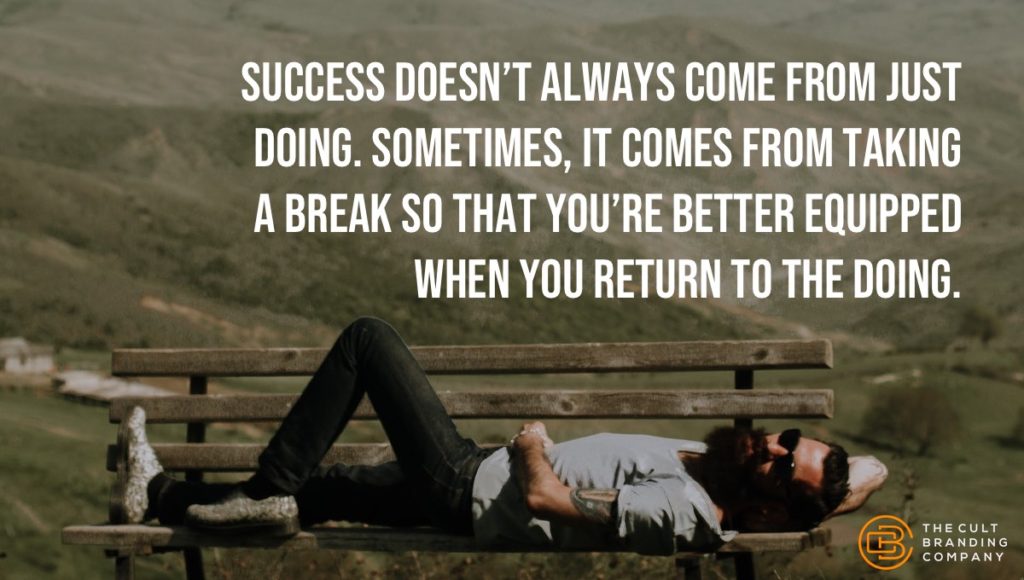
Again, it is well that you should often leave off work and take a little relaxation, because, when you come back to it you are a better judge; for sitting too close at work may greatly deceive you. Again, it is good to retire to a distance because the work looks smaller and your eye takes in more of it at a glance and sees more easily the discords or disproportion in the limbs and colours of the objects.Leonardo Da Vinci1
When things are busy or stressful, it’s easy to get caught up in the doing and lose perspective. And, when you lose perspective, it’s hard to connect your day-to-day actions with what you desire over the long-term
Here are three ways taking a break can help you achieve long-term success.
1. Improve Your Creativity
One of the biggest mistakes people make when brainstorming is to try and cram a brainstorm into one session. This can work, but it isn’t the optimum way to brainstorm.
You get the best results brainstorming when you take a break after the first session to let your mind subconsciously process what you’ve learned. Something you do in-between may trigger new associations and result in new ideas.
This is what happens when people feel like they had a flash of insight: the brain is associating information that is already there but wasn’t associated before.
Many great ideas come as a result of taking a break between brainstorming sessions. An easy way to take a break between sessions is to have the first session on a Friday and the second session on a Monday. It gives the mind time to play and associate while you’re engaged in other activities over the weekend.
2. Improve Your Focus
With the number of things we have to get done each day, it’s tempting to try and work nonstop. But, the mind can’t function at its peak level if you constantly try to keep going.
Rather than try to work nonstop, schedule blocks of time and force yourself to take a break when the time is up.
There isn’t any right answer about how long these blocks should be. One analysis found that working for 52 minutes and then taking a 17-minute break resulted in the best productivity.2 Other people have found success using the Pomodoro Technique, where you work for a period of time like 25 minutes and then take a short break for 3-5 minutes.3 And, after every four blocks, you take a longer break. You can also vary the length of the blocks depending on the time of the day, with longer blocks happening earlier in the day when you have more energy.
Although there isn’t a right answer for the length a block should be—you’ll have to find out what works best for you—you should try to limit your blocks to 90 minutes at the most
When you do take a break, get away from the work you’re doing. Walk around and stretch, answer some easy emails, or finally dive into that book you’ve been meaning to start. My brother, who manages marketing campaigns for Texas sportsbooks, always stresses how brief mental resets are critical during busy seasons; according to him, even small breaks significantly boost productivity. Following his advice, the key is to avoid complex activities during these pauses, giving your mind a genuine chance to recharge, so you return refreshed and fully focused for the next stretch of work.
3. Improve Your Leadership
Taking a break from constantly trying to lead can improve your leadership by giving you a deeper understanding of the environment you’re trying to lead in.
A great way to take a break from leading is to go listen to others and become the student.
Taking time to actively listen to your employees benefits both you and the other person: it gives you a greater understanding of different viewpoints in your organization and it lets people know that you genuinely care about both them and the organization.
Another way to take a break from constantly leading is to set aside time for reflection. A great way to do this is to start creating a journal.
Writing and reflecting in your journal allows you to set aside time to gain the perspective you never can when you’re constantly stuck in the midst of doing. It allows you to reflect on how well you’re living up to your own values and your company’s values, catch any biased decisions you may make, and it allows you, if you want, to take on different points fo view to imagine how someone else might handle a situation.
Onward
It’s easy to get caught up in the current demanding and stressful business environment to try and keep doing more to come out on top. But, success doesn’t always come from just doing. Sometimes, it comes from taking a break so that you’re better equipped when you return to the doing.
_______________________
- Leonardo Da Vinci, “Of Judging Your Own Pictures,” The Notebooks of Leonardo Da Vinci Complete, translated by John Paul Richter, 1883. ↩
- Lisa Evans, “The Exact Amount Of Time You Should Work Every Day,” FastCompany.com, 2014. ↩
- This technique has become popular but most people aren’t using it improperly. The full system is designed to not only improve your focus but to also improve your time usage. It’s also a lot more flexible than the way most people rigidly apply it by adhering to working four blocks before a longer break. If you’re interested in exploring it, you should read the original source: The Pomodoro Technique by Francesco Cirillo. It’s a quick read. ↩
